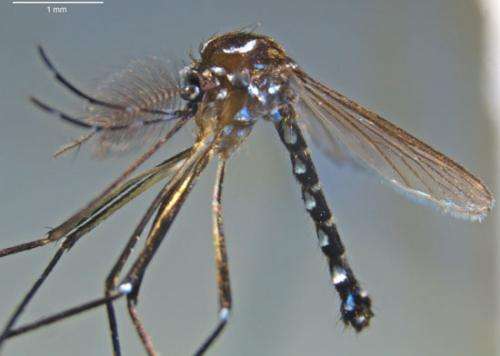Dengue fever, chikungunya: A potential vector discovered in Mayotte

IRD researchers and their partners at the French Regional Health Agency, Indian Ocean, have identified a new mosquito species in Mayotte, which could be a vector of dengue fever and chikungunya hitherto unknown. Stegomyia pia , as the scientists have named it, in fact belongs to a group of species that transmit these viruses. The notorious tiger mosquito is one of them. The discovery of this new Mahoran mosquito species, a potential vector, enables researchers to find out more about the mosquitoes that have to be dealt with, and will contribute to the effectiveness of prevention programmes for these diseases.
An unexpected discovery
The researchers went through the entire island with a fine-tooth comb in search of the slightest mosquito or larva. Their goal was to establish a complete inventory of Mahoran species. Thanks to detailed morphological studies and molecular sequencing of the collected specimens, entomologists were able to assemble a substantial diversity of species considering the small size of the region (376 km²). They listed 4 species of Stegomyia mosquito hitherto unknown, which they named Stegomyia pia . Its shiny black body is adorned with shimmering silvery or yellow scales – "pia" means "pretty" in Shimaore, the language of Mayotte. A pest in a flattering disguise…
Strong suspicions surround the new species
Stegomyia pia indeed has the potential to transmit serious viral diseases like dengue fever and chikungunya, which are rampant in the Indian Ocean and the Pacific. It belongs to the same group as Aedes aegypti as well as Aedes albopictus , better known as the tiger mosquito. The species in this group are not only very similar in a morphological and physiological respect, but also have many life-cycle traits in common: preferred breeding areas for larvae, feeding habits, and longevity. All of them are known for transmitting infections through their bite. As the inventory was mainly based on aquatic larvae stages outside of the epidemic period, the scientists were not able to capture Stegomyia pia carrying one of these viruses in order to demonstrate its vector capacity, but grave suspicions surround this new species.
Learning more about transmitter mosquitoes
The 4th species of Stegomyia in Mayotte appears to be endemic to the island: researchers have established that Stegomyia pia is an indigenous species, in other words not introduced from another region like its cousin the "tiger mosquito", which comes from Southeast Asia. It seems to be a relatively abundant species, as it was identified in 6% of the 420 sampling sites, mainly in small amounts of water that collect in holes left by chopped trees and bamboo. The discovery of this new Mahoran species, a suspected vector, will tell researchers more about the mosquitoes that need to be dealt with, including their particular traits, behaviour and feeding habits, in order better to prevent the risk of transmission of the diseases. The research teams are now assessing the mosquito's vector capacity and female adults' preferences when it comes to hunting for blood.
More information: Gilbert, L., Cecile, B. and Vincent, R. Stegomyia mosquitoes in Mayotte, taxonomic study and description of Stegomyia pia n. sp. Parasite, 2013, 20, 31. dx.doi.org/10.1051/parasite/2013030
Provided by Institut de recherche pour le developpement



















